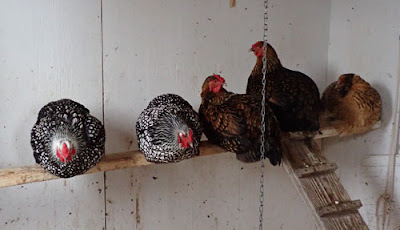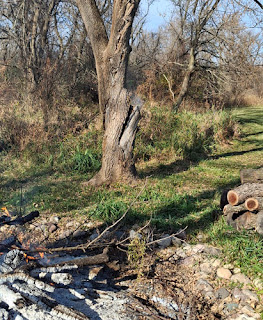Last Monday we had almost an inch of rain.
 |
| Almost an inch! |
We were glad for the rain. Bingo, however, dealt with the dreary day but crawling in the pillow case that is supposed to protect the cat bed from fur.
 |
| I'll just stay here until spring |
Banjo preferred to sit on my lap for tummy rubs.
 |
| What? Are you done rubbing my tummy already? |
Later that day, Bingo crawled under the blanket that is supposed to protect the chair from fur. Somehow he worked himself into a Bingo roll.
 |
| Or maybe I'll stay here until spring |
Later on, Banjo joined him.
 |
| Hey, Bro, what's going on? |
Here, Banjo is either licking Bingo’s face or telling him a secret.
 |
| Psst... |
I took a walk back to the creek on Tuesday. Water filled it to its banks for the first time since midsummer. Obviously, it would need a lot more water to flood. A lot.
 |
| The creek filled to the banks, but a long way from flood stage |
As the leaves have dropped, hidden secrets in the tree crowns are revealed. In this case, it’s an oriole nest. Orioles weave intricate hanging nests from the branches. How do they manage that without hands? I can’t imagine weaving anything with my mouth, but there you are.
 |
| Hanging oriole nest |
I was supposed to go to retiree coffee on Thursday, but the snow was blowing horizontally, and I couldn’t see across the corn field across the road. I’m retired, for heaven’s sake. I don’t need to go out in bad weather. Look at me, acting my age! We had enough snow and wind to get drifts.
 |
| The first drifts of the winter |
Bingo, once again, sought refuge under his blanket. He’s so cute. I’m glad we brought him home with his brother, even though he was hissy at first.
 |
| Seriously, I'm not coming out this time |
He as taken to sitting on the back of my chair. Banjo does that too sometimes, but unlike Banjo, Bingo does not chew on my hair. Good boy! It is amazing how flat that cat can get. He must have very flexible ribs.
 |
| Flat cat |
The chickens were put out by the snow. They hunkered down in the coop and mostly refused to lay. We only had two eggs for the day.
 |
| Perched for the duration of the storm |
When the snow let up, Silvia and Lucky ventured out, even though it was still windy. I suppose that’s because those two are most likely to get picked on.
 |
| Silvia and Lucky go for a walk after the snow stops |
Much to her dismay, Silvia discovered that the dust bath was closed for the day. Poor Silvia.
 |
| What's up with this?? My feet are wet and cold, and I need some dry sand. |
The snow melted. It seems that Lucky is becoming more integrated into the flock. Some of the other girls still chase her away from the scratch grains, but she seems to find opportunities to eat.
 |
| Lucky, upper center with the white fluffy butt, is better able to get her share of the scratch grains. |
It warmed up again, but is supposed to get down in the twenties before Thanksgiving. Brussels sprouts will take 30’s, but not 20’s. I went out yesterday and harvested the rest of them.
 |
| Lots of sprouts |
I even dug up the stems. The garden is really, truly done now.
 |
| Bucket o' stems |
Now it's time for Thanksgiving. After that, I'll start in making jam from the fruit I froze in the summer.








































